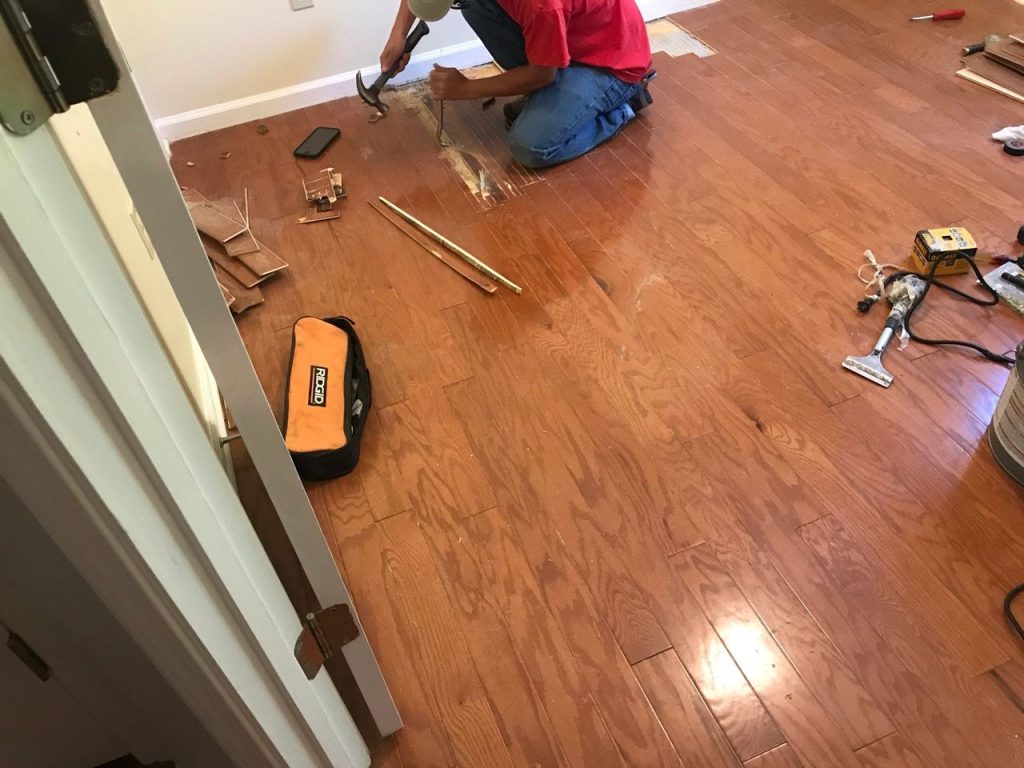Wondering if you can sand engineered wood flooring to restore its beauty? The answer isn’t as straightforward as you might think – here’s what you need to know.
Understanding Engineered Wood Flooring
Engineered wood flooring represents a remarkable innovation in flooring technology, combining the timeless beauty of natural wood with enhanced stability and durability. Unlike solid hardwood, which is crafted from a single piece of timber, engineered wood flooring consists of multiple layers. The top layer, known as the wear layer or veneer, is made from genuine hardwood, while the core comprises several layers of high-quality plywood or high-density fibreboard (HDF) arranged in a cross-grain pattern. This sophisticated construction offers superior resistance to moisture and temperature fluctuations, making it increasingly popular in British homes, with sales growing by 25% in 2023.
Can Engineered Wood Flooring Be Sanded?
The ability to sand engineered wood flooring depends primarily on the thickness of its wear layer. According to industry standards, floors with a wear layer of 2-3mm or more can typically be sanded, while those with thinner layers should not undergo this process. Professional flooring experts recommend a minimum wear layer thickness of 4mm for optimal sanding results. The number of times you can sand your engineered wood floor varies: floors with 2-3mm wear layers can usually be sanded 1-2 times, while those with 6mm layers might allow for 4-5 sandings throughout their lifetime.
How to Check Your Floor’s Wear Layer
- Look for original product specifications or documentation
- Measure the exposed edge where the flooring meets a threshold
- Consult a professional flooring specialist for accurate assessment
- Check the manufacturer’s website for product information
When to Sand Engineered Wood Flooring
Recognising the right time to sand your engineered wood flooring is crucial for maintaining its appearance and longevity. Common indicators include: visible surface scratches, dull or worn areas, light surface damage, and minor discolouration. However, it’s essential to note that not all wear patterns require complete sanding. In some cases, light buffing or screen sanding might suffice. According to recent industry data, approximately 65% of engineered wood floors can benefit from professional sanding at least once during their lifetime.
The Sanding Process: Professional Tips
- Start with thorough cleaning and room preparation
- Begin with 60-grit sandpaper for initial sanding
- Progress gradually through finer grits (80, 100, 120)
- Sand in the direction of the wood grain
- Maintain consistent pressure and movement
- Vacuum between grits to remove dust
- Check progress frequently to avoid over-sanding
Professional vs DIY Sanding
While DIY sanding might seem cost-effective, professional sanding offers significant advantages. Professional services typically cost between £25-35 per square metre in the UK, but this investment often proves worthwhile. Professional sanders have access to industrial-grade equipment, possess extensive experience in handling different wood types, and understand the precise techniques needed for optimal results. DIY attempts, while possible, carry risks of damaging the wear layer or creating an uneven surface, potentially leading to costly repairs or replacements.
After Sanding: Finishing and Maintenance
Post-sanding care is crucial for ensuring the longevity of your newly refreshed floor. The finishing process should begin within 24 hours of sanding to protect the exposed wood. Modern water-based polyurethane finishes have become increasingly popular, offering excellent durability while being environmentally friendly. For optimal results, apply 3-4 coats of finish, allowing proper drying time between applications.
Maintenance Tips
- Use felt pads under furniture legs
- Clean spills immediately to prevent staining
- Vacuum or sweep regularly with soft bristles
- Use manufacturer-recommended cleaning products
- Maintain consistent indoor humidity levels
Expert Recommendations and Final Thoughts
Successful engineered wood floor sanding requires careful consideration of multiple factors. The key to success lies in proper assessment, preparation, and execution. For most homeowners, particularly those with limited experience, professional sanding services offer the best value proposition, ensuring optimal results and maximum floor longevity. Recent studies show that professionally sanded and maintained engineered wood floors can extend their lifespan by up to 15-20 years.
Get Professional Help in Bromley
At Bromley Tilers, we specialise in all aspects of flooring, including expert engineered wood floor sanding and restoration. Our team of experienced professionals uses state-of-the-art equipment and proven techniques to deliver exceptional results. We serve the Bromley and Kent areas, offering comprehensive flooring solutions tailored to your specific needs. Contact us today at 020 XXXX XXXX for a free consultation and quote. Trust our expertise to breathe new life into your engineered wood flooring while maintaining its integrity and beauty for years to come.
FAQ
How many times can you sand engineered wood flooring?
The number of times you can sand engineered wood depends on the thickness of the veneer. Typically, you can sand an engineered floor once or twice, as excessive sanding can easily expose the layers beneath, damaging the floor irreparably.
How do you get dirt out of engineered hardwood floors?
Tip #1: Sweep or vacuum daily Sweeping or vacuuming away dust, dirt, and debris frequently is not only the easiest tip for cleaning engineered hardwood flooring, but it will also prevent these contaminants from being ground beneath your feet into the surface of the floor, creating scratches and causing premature wear.
How much does sanding engineered hardwood cost?
The cost of sanding typically falls between $1.50 and $3 per square foot. This price includes labor and materials, but it can vary based on factors such as the condition of the floors and the region in which you live.
What is the best sander for engineered wood floors?
Orbital sanders are especially suitable for engineered wood floors due to their gentle sanding action, which is less likely to damage the wood grains or wear layer. It is crucial to select finer grits for finishing to ensure a smooth surface, ready for a new coat of finish.
Is it worth it to refinish engineered hardwood?
Is it worth it to refinish engineered hardwood floors? Absolutely, if the veneer layer is thick enough. Refinishing can extend your floor’s life and enhance its look.
Sources
[1] https://luxuryflooring.co.uk/news/sanding-engineered-wood-floors-can-it-be-done/
[2] https://www.youtube.com/watch?v=VGly2HnZJMc
[3] https://www.pistonheads.com/gassing/topic.asp?h=0&f=207&t=2087905



